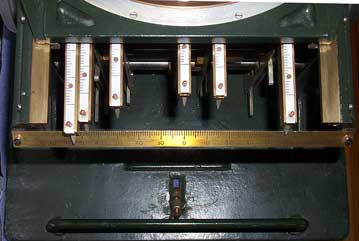Comparator Hypotheses
(continued)

While this is our best
guess so far, there are some things that just don't fit, or, at
least, that we just don't understand.
- The machine is labeled
"comparator." If the machine is a comparator, what
does it compare? We researched other devices with this name,
for example, optical comparators, and they're very different.
- The output seems to
be on top, but there are no calibrations on the top scales. You
can zero out a scale by sliding it, but what you read out is
just coarse divisions.
- Although the machine
is very precise in its construction, the scales do not seem to
be designed for precise entry. If there were a vernier scale
on each of the "input" dials, it would be easy to enter
a value to 1/10th of a division. The lack of fine divisions or
a vernier scale suggests that precision wasn't terribly important.
So why build a big, heavy device? A more-practical approach to
the engineering problem would be to use a (custom) slide rule
instead.



